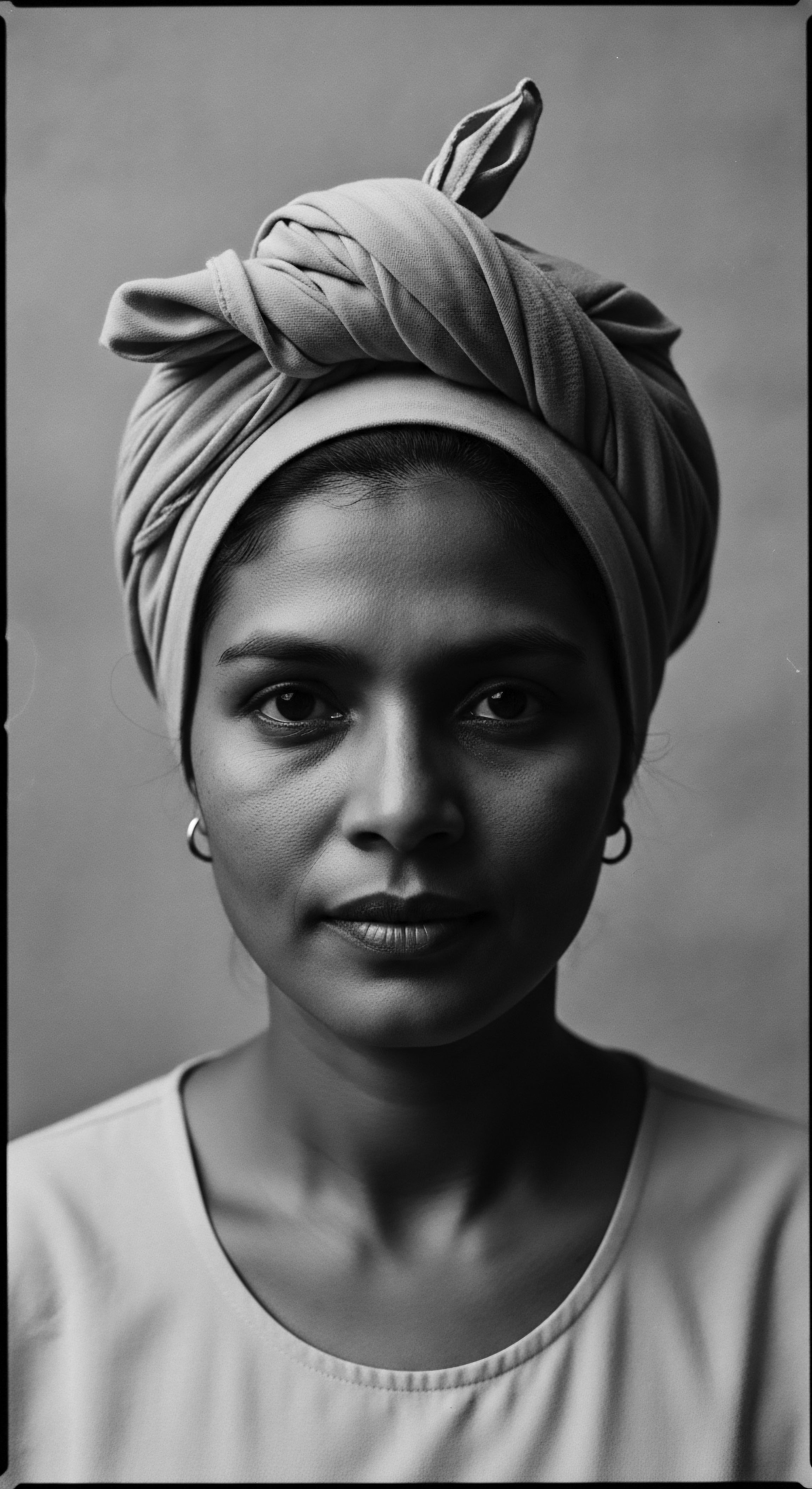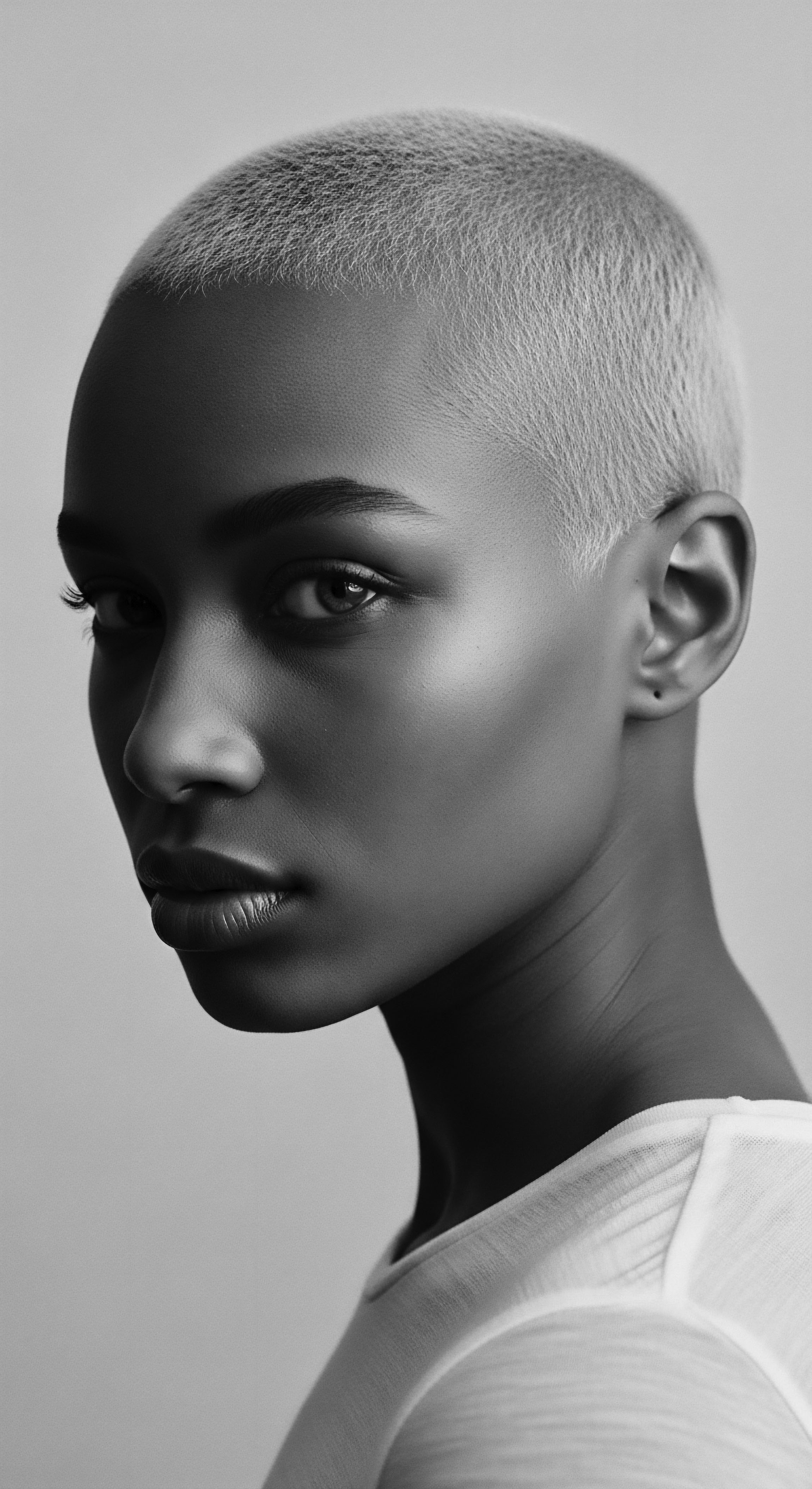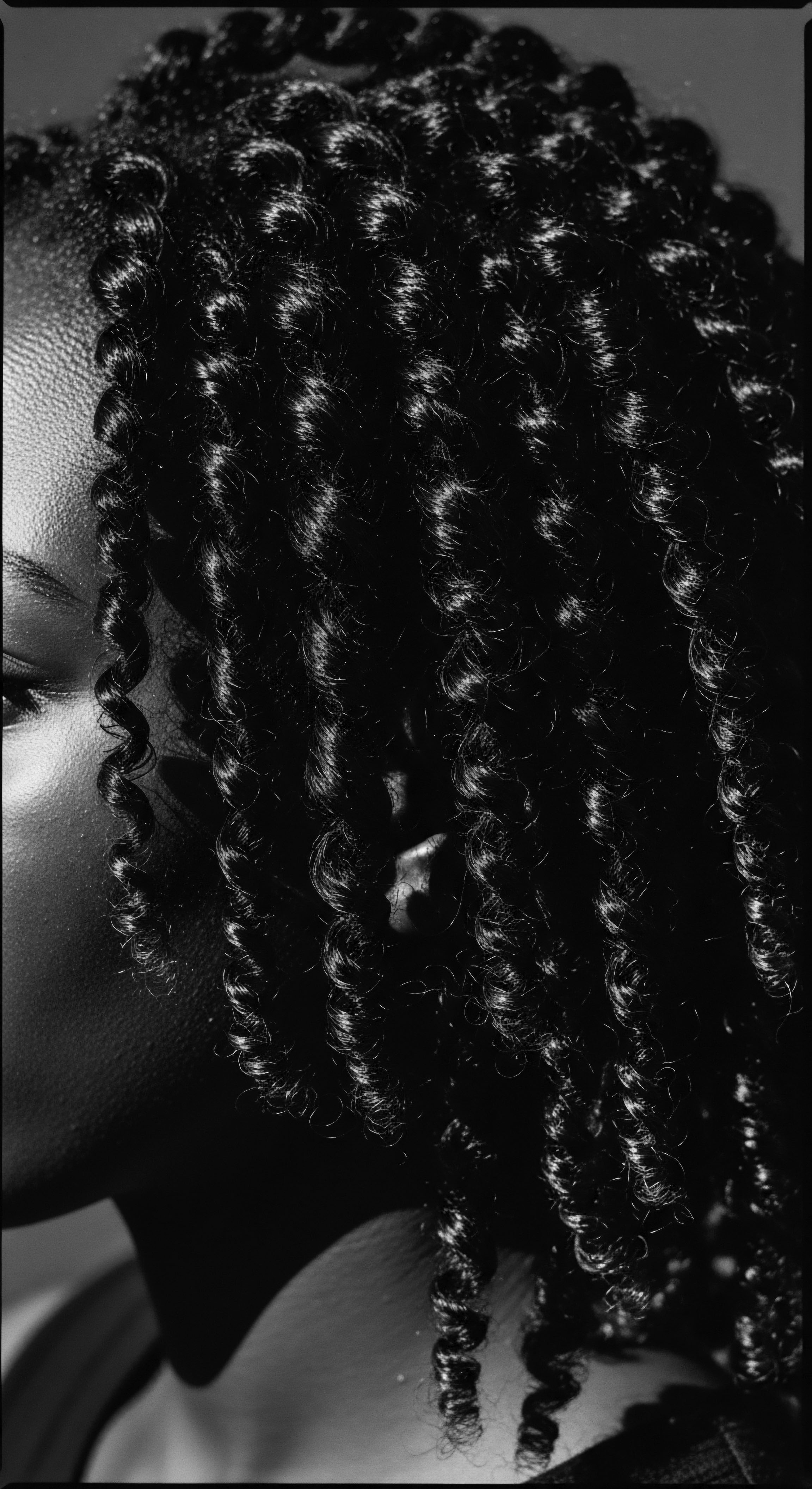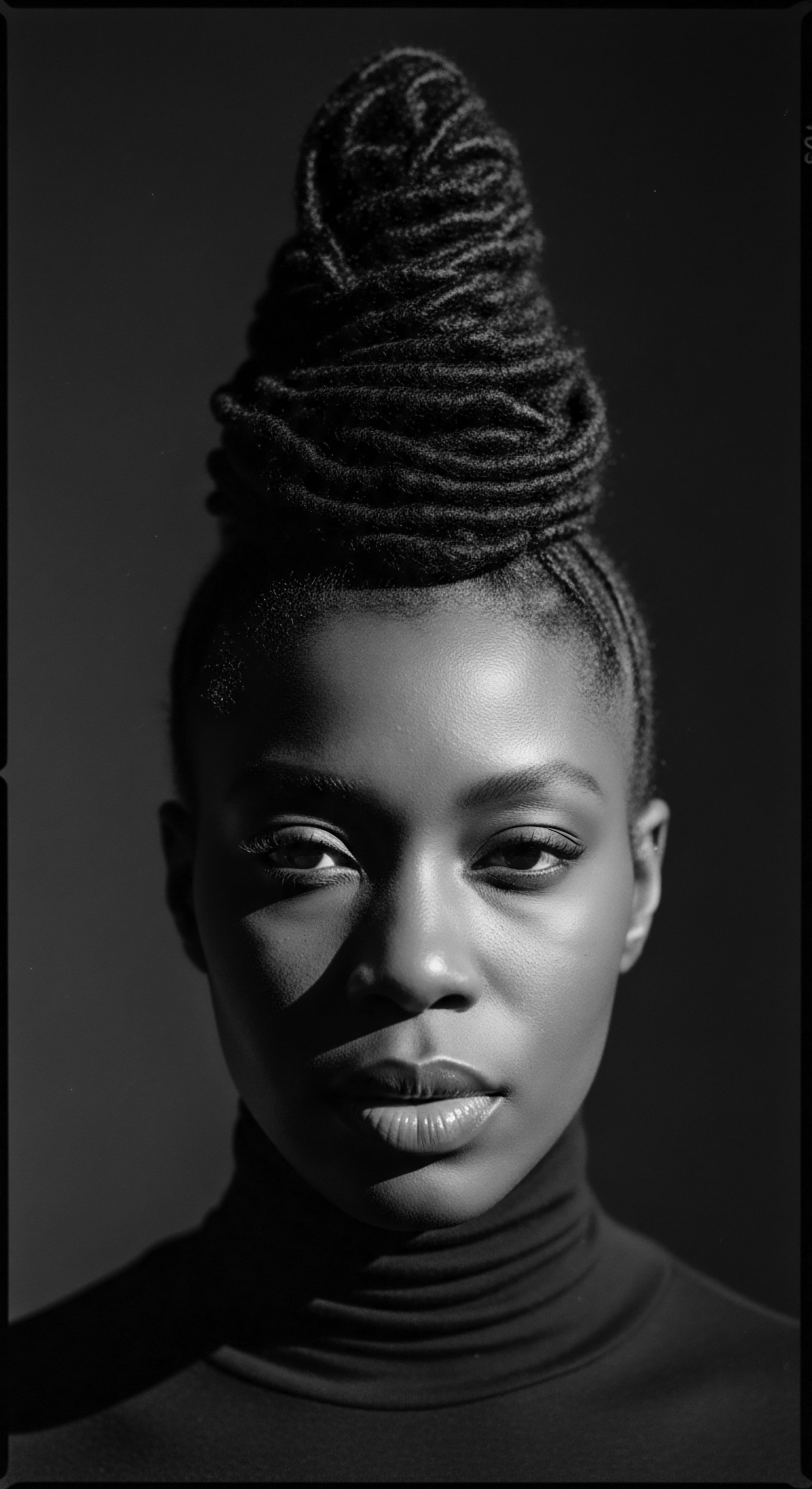
Fundamentals
The experience of dryness on the scalp, often described as a tautness or an uncomfortable itch, traces back through shared human biology and the distinctive journey of textured hair. At its simplest, the scalp, like any skin, seeks a balanced state of hydration to flourish. When this delicate equilibrium falters, a sensation of lacking moisture settles in, marking the presence of scalp dryness.
This condition is an expression of the skin’s barrier function, its outermost protective layer, struggling to retain vital moisture. It is a fundamental disruption to the scalp’s health, affecting comfort and setting the stage for other hair concerns.
Understanding the scalp’s basic biology unveils the elemental mechanisms behind its dryness. The scalp’s epidermis, its outermost layer, acts as a guardian, a living shield that safeguards the inner tissues from environmental aggressors while preventing excessive water from escaping. This barrier depends on a harmonious blend of lipids, notably ceramides, cholesterol, and fatty acids, along with natural moisturizing factors. These elements form a resilient, well-ordered structure, a finely constructed wall against desiccation.
When this protective layer is compromised, water within the skin evaporates more readily, a phenomenon known as transepidermal water loss. The feeling of dryness arises from this diminished hydration, leading to sensations of discomfort, flaking, or even mild irritation.
Scalp dryness manifests when the skin’s barrier struggles to retain essential moisture, reflecting an imbalance in its protective mechanisms.
For individuals with textured hair, particularly those within Black and mixed-race communities, the meaning of scalp dryness deepens, extending beyond a mere biological occurrence. It resonates with ancestral practices and the ongoing legacy of care. The inherent structural characteristics of tightly coiled or curly hair, for instance, mean that natural sebum, the scalp’s own conditioning oil, finds a more winding path to travel down the hair shaft.
This anatomical reality contributes to a predisposition for drier strands, which can then influence perceptions of scalp hydration. Generations have navigated this reality, developing practices designed to deliver moisture directly to the scalp and hair, often using richly emollient plant oils and butters passed down through family wisdom.

The Skin’s Thirst ❉ A Simple Delineation
A straightforward explanation of scalp dryness identifies it as a state where the scalp lacks sufficient moisture. This might be due to various factors ❉ environmental conditions, such as low humidity or harsh winds, which strip away hydration; frequent washing with harsh cleansers that disrupt the scalp’s natural oils; or even a genetic predisposition that influences the skin’s ability to hold onto water. In its simplest form, it is the scalp crying out for hydration, a clear signal that its protective envelope requires attentive care. The sensation might be subtle at first, a faint tightness, before progressing to visible flaking or persistent itching.
The experience of scalp dryness within Black and mixed-race hair traditions has been a consistent thread throughout history. Oral histories and community practices speak to a long-standing awareness of the scalp’s unique needs, often separate from discussions of hair strand hydration. Traditional hair care rituals, whether in ancestral African villages or within diaspora communities, consistently feature practices aimed at comforting and moisturizing the scalp. This historical consciousness sets a precedent, grounding our modern understanding of scalp dryness in a lineage of mindful attention and adaptive care.

Early Signs and Sensations
- Tightness ❉ A feeling that the scalp skin is stretched, especially after washing or in dry conditions.
- Itching ❉ A persistent urge to scratch, often a primary indicator of reduced scalp hydration.
- Flaking ❉ Small, white, dry particles that detach from the scalp, distinct from the larger, oilier flakes associated with dandruff.
- Dullness ❉ A lack of vibrancy in the hair near the roots, which can be an indirect sign of an unhealthy scalp environment.
These primary indicators served as guides for earlier generations, signaling when the scalp needed replenishment. Ancestral wisdom often translated these signs into calls for specific remedies, employing natural oils, herbal infusions, and gentle cleansing rituals designed to restore comfort and vitality to the scalp.

Intermediate
Moving beyond the basic meaning, scalp dryness represents a more complex interplay of physiological factors, environmental influences, and established care practices, particularly within the context of textured hair. It is not merely the absence of water on the skin’s surface, but a systemic disruption of the stratum corneum’s integrity, leading to impaired barrier function. This impaired barrier allows for increased transepidermal water loss, fundamentally altering the scalp’s microenvironment. The term signifies a need for a deeper understanding of the scalp’s epidermal lipid matrix and its role in maintaining hydration, especially where cultural hair styling and historical care methods have shaped distinct scalp health profiles.
The skin’s ability to retain moisture is inextricably tied to the composition and organization of its lipids. Ceramides, crucial components of the stratum corneum, operate as the mortar between the brick-like skin cells, forming a formidable barrier. When ceramide levels are reduced or their arrangement is disrupted, the scalp becomes more permeable, leading to heightened water loss and the manifestations of dryness. This biochemical reality holds particular meaning for individuals with Black and mixed-race hair.
Research indicates that Black skin can possess lower levels of ceramides and experience greater transepidermal water loss compared to White skin (Berardesca & Maibach, 1988; Wilson et al. 1988). This inherent physiological difference suggests a foundational predisposition to dryness, demanding particular attention to scalp hydration and care practices within these communities.
Scalp dryness, especially for textured hair, reflects a compromised barrier function with reduced ceramides and increased transepidermal water loss, necessitating specialized care approaches.
Consider the profound significance of this physiological distinction in the ancestral journey of Black hair care. Generations removed from the African continent, where diverse herbal remedies and natural emollients were readily available, enslaved peoples in the Americas and other diasporic lands had to adapt. Without consistent access to traditional ingredients, or even clean water and proper tools, the innate susceptibility to scalp dryness became a persistent challenge.
Historical accounts recount the resourceful, albeit often inadequate, use of whatever materials were at hand—from kitchen oils to other, less suitable, substances—to bring comfort and a semblance of health to the scalp. This historical burden underscores the profound ancestral connection to scalp health concerns and the resilience required to manage them.

Physiological Underpinnings and External Impacts
The physiological definition of scalp dryness extends to the precise mechanisms governing skin hydration. It describes a state where the stratum corneum, the outermost layer of the epidermis, loses its capacity to adequately regulate water content. This can arise from several factors:
- Compromised Barrier Function ❉ A weakened epidermal barrier, perhaps due to genetic predispositions or external aggressors, permits water to escape the skin more readily. This means the protective shield of the skin is less effective at its fundamental task of moisture retention.
- Insufficient Sebum Production ❉ While textured hair often struggles with sebum distribution along the hair shaft due to its coiled structure, some individuals may also have underactive sebaceous glands on the scalp itself. This reduces the natural lipid film that would ordinarily help seal in moisture.
- Environmental Stressors ❉ Exposure to dry air, harsh winds, or extreme temperatures can accelerate water evaporation from the scalp. These external factors can overwhelm the scalp’s natural defenses, leading to noticeable dryness.
- Improper Hair Care Practices ❉ Frequent use of stripping shampoos, products containing harsh alcohols, or excessive heat styling can compromise the scalp’s lipid barrier, leading to increased transepidermal water loss. The very act of washing, if not followed by appropriate moisturizing, can temporarily disturb the scalp’s moisture balance.
The implications of these factors are particularly noteworthy for textured hair. The unique morphology of hair follicles in individuals of African descent, creating highly coiled strands, directly influences how natural oils move from the scalp down the hair shaft. This structural reality means that while the scalp might produce sebum, the hair strands themselves may experience dryness, leading to a common misconception that the scalp is inherently dry. This often prompted, and continues to prompt, practices of heavy oiling to combat perceived hair dryness, which, if not balanced with proper cleansing, can sometimes paradoxically exacerbate certain scalp conditions (Seeborg et al.
2013). This highlights the intricate connection between hair texture, scalp health, and traditional care rituals.

The Echo of Ancestral Wisdom in Modern Care
The practices developed across generations within Black and mixed-race communities speak volumes about a living, evolving knowledge system around scalp health. Ancestral methods of care, often rooted in natural elements, were early forms of preventative medicine for scalp dryness.
| Aspect of Care Moisturizing Agents |
| Traditional Approach (Ancestral Roots) Shea butter, cocoa butter, coconut oil, palm oil, natural plant extracts |
| Contemporary Link to Scalp Dryness Understanding These natural emollients provide lipids and occlusive properties that help to reduce transepidermal water loss and replenish the scalp's barrier. |
| Aspect of Care Application Method |
| Traditional Approach (Ancestral Roots) Direct application to scalp, gentle massage, braiding/twisting hair with oils |
| Contemporary Link to Scalp Dryness Understanding Direct application ensures penetration to the scalp skin, while massage improves circulation. Protective styles help seal in moisture. |
| Aspect of Care Cleansing Frequency |
| Traditional Approach (Ancestral Roots) Less frequent washing (e.g. weekly or bi-weekly), water-only rinses, herbal washes |
| Contemporary Link to Scalp Dryness Understanding Recognizes the scalp's delicate lipid barrier and the need to preserve natural oils. Over-washing can strip the scalp and exacerbate dryness. |
| Aspect of Care Protective Styling |
| Traditional Approach (Ancestral Roots) Braids, twists, wraps, head coverings for sun/wind protection |
| Contemporary Link to Scalp Dryness Understanding Shields the scalp from harsh environmental elements that accelerate moisture loss, preserving hydration. |
| Aspect of Care These practices, though often developed intuitively, align with modern scientific understanding of scalp barrier function and moisture retention. |
The reverence for protective styles, the judicious use of water, and the purposeful application of plant-based oils stand as enduring testaments to a profound understanding of scalp health, centuries before the advent of laboratory analysis. This historical record compels us to acknowledge that the pursuit of a comfortable, well-hydrated scalp is a legacy, a continuous conversation between ancient wisdom and scientific discovery.

Academic
The academic understanding of scalp dryness represents a rigorous investigation into the intricate biophysical and biochemical processes governing skin hydration, viewed through a lens that acknowledges its deep cultural and historical implications, particularly for individuals with textured hair. It moves beyond symptomatic observations to explore the underlying molecular mechanisms, genetic predispositions, and the profound impact of environmental and socio-historical factors. At its most precise, scalp dryness is delineated as a condition of epidermal desiccation characterized by a compromised stratum corneum barrier, leading to elevated transepidermal water loss (TEWL) and a diminished capacity for internal moisture retention. This phenomenon, while universally recognized, assumes particular significance and complexity within the context of Black and mixed-race hair experiences, where inherent physiological differences intersect with deeply rooted care traditions and systemic challenges.
The scientific comprehension of scalp dryness must contend with inherent variations in skin physiology across diverse populations. Seminal research by Wilson et al. (1988) and subsequent work by Berardesca and Maibach (1988) demonstrated that Black skin, when compared to White skin, exhibits a significantly higher baseline TEWL, with some investigations reporting a 2.7-fold increase in passive water vapor loss. Furthermore, studies indicate that Black skin often possesses lower levels of essential epidermal lipids, such as ceramides.
This evidence provides a compelling scientific foundation for why scalp dryness may be a more prevalent and persistent concern within communities of African descent. The reduced ceramide content compromises the integrity of the epidermal lipid lamellae, weakening the skin’s primary moisture barrier and increasing its vulnerability to external irritants and water evaporation.
Academic inquiry reveals scalp dryness in textured hair is a complex state involving inherent physiological differences, such as higher transepidermal water loss and lower ceramide levels, compounded by historical care practices.
The academic investigation also recognizes that while these physiological distinctions establish a foundational susceptibility, they do not operate in a vacuum. The cultural practices of hair care, many of which evolved as adaptive responses to environmental conditions or as expressions of identity, have a tangible impact on scalp health. For instance, the use of occlusive agents, common in many traditional African and diasporic hair routines, can paradoxically contribute to issues if not balanced with appropriate cleansing, potentially fostering environments conducive to conditions like seborrheic dermatitis, which is prominent among Black women and can be exacerbated by excessive use of hair oils or infrequent washing. This intersection of biology and practice necessitates a holistic, culturally informed approach to scientific inquiry, moving beyond simplistic correlations to understand the multifaceted nature of scalp well-being.

The Interplay of Physiology, Heritage, and Environmental Determinants
A deeper look into the meaning of scalp dryness requires an examination of its multifaceted origins. The epidermal barrier, a dynamic structure, responds to both internal programming and external stressors. For individuals with textured hair, this response is particularly influenced by genetic heritage and socio-historical conditioning.

Genetic and Biophysical Predispositions
The unique helical structure of highly coiled hair follicles means the hair shaft itself provides less direct coverage to the scalp compared to straighter hair textures. This can expose the scalp to environmental elements, potentially increasing moisture loss. Beyond this physical characteristic, the biophysical properties of the scalp skin in individuals of African descent present distinct considerations. The observation of increased TEWL in Black skin is a critical data point, signifying an inherent challenge in moisture retention.
This physiological reality, while not meaning all Black scalps are perpetually dry, does suggest a heightened need for external intervention to maintain optimal hydration. The reduced ceramide levels contribute to a less efficient barrier, meaning that even in ambient conditions, the scalp may experience a steady, often unacknowledged, evaporation of water. This is not a pathology but a characteristic, one that has shaped generations of hair care wisdom.
Moreover, variations in the filaggrin gene, which is essential for skin barrier function and hydration, are also being explored for their differential prevalence across populations. While initial studies on filaggrin mutations linked them primarily to atopic dermatitis in Caucasian populations, ongoing research into its expression and function in skin of color provides further insights into potential predispositions to conditions like dryness and eczema. This genomic variation, while not fully understood in its direct contribution to typical scalp dryness, hints at deeper inherited factors influencing skin barrier robustness.

Ancestral Practices and Adapted Realities
The historical legacy of hair care within Black and mixed-race communities offers a profound elucidation of scalp dryness. Generations, particularly during and after chattel slavery, faced the stark challenge of maintaining scalp health without the traditional resources of their homelands. Forced adaptation led to the inventive, though sometimes detrimental, use of readily available substances. Early attempts at hair straightening, for instance, involved processes like hot combs and various greases that could irritate the scalp, potentially compromising its barrier and exacerbating dryness or leading to other dermatological conditions.
These practices, often born from necessity or societal pressures to conform to Eurocentric beauty standards, could inadvertently create a vicious cycle. The perceived dryness might be addressed with heavy occlusive products, but if not accompanied by proper cleansing and targeted hydration, this could lead to follicular occlusion, inflammation, or even scarring alopecias such as central centrifugal cicatricial alopecia (CCCA), a condition disproportionately affecting women of African descent (Lenzy, 2016). In a study of 5,594 African-American women, 47.6 percent reported hair loss on the crown or top of the scalp, with many cases aligning with CCCA, a condition often linked to inflammation and scarring. This statistic underscores how deeply intertwined scalp health, styling practices, and heritage are for these communities.
| Historical Practice Oiling/Greasing Scalp (Heavy) |
| Traditional Purpose / Context To combat perceived dryness, add shine, facilitate styling for tight curls, seal moisture. |
| Potential Scalp Dryness / Health Implications May clog pores, contribute to product build-up, potentially exacerbate seborrheic dermatitis if not cleansed adequately. |
| Historical Practice Infrequent Washing |
| Traditional Purpose / Context To preserve styles, prevent dryness, due to limited access to water or suitable products. |
| Potential Scalp Dryness / Health Implications Accumulation of sebum, dead skin cells, and product residue, which can irritate the scalp and contribute to dryness or other conditions if not managed. |
| Historical Practice Hot Combs/Chemical Relaxers |
| Traditional Purpose / Context To straighten hair, achieve desired texture for social/aesthetic reasons. |
| Potential Scalp Dryness / Health Implications Direct thermal or chemical damage to scalp, irritation, inflammation, barrier disruption, potential for scarring alopecia over time. |
| Historical Practice Protective Styling (Braids/Twists) |
| Traditional Purpose / Context To manage hair, reduce manipulation, promote growth, express identity. |
| Potential Scalp Dryness / Health Implications Excessive tension can cause traction alopecia; improper cleansing during long-term styles can lead to scalp build-up and irritation if not properly cared for. |
| Historical Practice These practices, while often culturally significant, demonstrate the ongoing journey of balancing aesthetic desires with intrinsic scalp health. |
The historical record reveals a complex dynamic where adaptive genius met challenging circumstances. The deep significance of healthy scalp care, passed down through generations, is not just about avoiding discomfort. It became a silent assertion of dignity, a form of self-preservation in contexts where external appearance was often scrutinized and devalued. This background enriches the academic understanding of scalp dryness by embedding it within a rich human story of resilience and adaptation.

Pathophysiological Manifestations and Clinical Interpretations
From a dermatological standpoint, the concept of scalp dryness is often intertwined with other scalp conditions that present with similar symptoms. Differential diagnosis is critical, as the underlying pathology may vary considerably.
- Xerosis Cutis ❉ This is the clinical designation for general skin dryness, which can affect the scalp. It is characterized by a decrease in water content in the stratum corneum, often leading to flaking, itching, and a rough texture. Its interpretation focuses on barrier repair and rehydration.
- Asteatotic Eczema ❉ Sometimes referred to as “winter itch,” this condition arises from severe dryness and presents with inflamed, cracked, and itchy skin. It is a more intense manifestation of compromised barrier function, often requiring anti-inflammatory interventions alongside moisturization.
- Pityriasis Capitis Simplex (Dandruff) ❉ While often associated with excess oil (seborrhea), a “dry dandruff” can occur, where flakes are smaller and whiter. This form indicates a dysfunctional scalp barrier that might be exacerbated by dryness, allowing for increased microbial activity.
- Seborrheic Dermatitis ❉ Although typically characterized by oily, yellowish scales and inflammation, seborrheic dermatitis on dry scalp can also exist, especially if the dryness is a result of harsh cleansing that strips lipids, disrupting the microbiome and allowing Malassezia yeast overgrowth.
The distinction between these conditions, while presenting similarly, holds critical implications for treatment. A true meaning of scalp dryness, from an academic perspective, requires a careful assessment of its direct physiological parameters, such as TEWL measurements, alongside a thorough patient history that includes hair care practices and cultural heritage. An AI-driven platform that measures scalp barrier function and TEWL has shown promise in improving scalp health and hair texture. Such technologies could potentially refine the diagnostic process, but they must be interpreted within the broader context of individual and communal experiences with hair care.
The pursuit of a precise academic definition of scalp dryness in textured hair contexts also acknowledges the psychosocial dimensions. The discomfort and visible flaking can lead to embarrassment and impact self-perception, sometimes influencing daily routines like exercise due to concerns about “messing up” hair, as a study revealed nearly half of African American women avoided physical activity due to hair concerns. This underscores that the significance of scalp dryness extends beyond biology, touching upon identity, cultural norms, and mental well-being. A truly comprehensive understanding requires this nuanced, interdisciplinary perspective, honoring the complexity of human experience intertwined with biological realities.

Reflection on the Heritage of Scalp Dryness
As we close this dialogue on scalp dryness, we recognize it as more than a dermatological condition. It stands as a profound testament to the enduring journey of textured hair, echoing through time from ancestral lands to contemporary salons. The scalp, a living canvas, records not only the tales of our personal care routines but also the collective wisdom of generations.
Its dryness, when it manifests, speaks of a shared human need for balance and a unique story of adaptation within Black and mixed-race communities. The very existence of this condition compels a deeper reverence for the practices and resilience that have sustained hair health through centuries of changing landscapes and circumstances.
The ongoing pursuit of comfort and vitality for the scalp is a thread that connects us directly to those who came before. Each application of nourishing oil, every gentle finger-pad massage, every careful choice of protective style, carries the weight of ancestral knowledge. These acts are more than mere routine; they are expressions of care, passed down and re-imagined, affirming the intrinsic value of every curl, coil, and strand. The struggle against dryness, understood within its heritage, becomes a symbol of continuity, a quiet insistence on self-preservation and beauty against a backdrop of historical challenges.
The future of understanding scalp dryness in textured hair lies in this harmonious synthesis—a blend of rigorous scientific inquiry with the rich, living archive of traditional wisdom. It means recognizing that the inherent biophysical differences of certain hair types are not deficits, but rather unique characteristics that have necessitated specialized approaches to care. It calls for formulations and practices that respect this heritage, acknowledging the unique needs and historical burdens of Black and mixed-race scalps. In this spirit, the alleviation of scalp dryness becomes a deeper engagement with wellness, a homage to the ingenuity of our forebears, and a purposeful step towards a future where every scalp can find its fullest expression of health and comfort, truly a reflection of the Soul of a Strand.

References
- Berardesca, E. & Maibach, H. I. (1988). Racial differences in skin physiology. British Journal of Dermatology, 119(5), 647-652.
- Lenzy, Y. M. (2016). Hair loss in African-American women ❉ Addressing challenges and promoting awareness. Presented at the American Academy of Dermatology’s 74th Annual Meeting.
- Seeborg, L. M. McMichael, A. J. & Camacho, F. T. (2013). Hair and scalp disorders in women of African descent ❉ an overview. Journal of the American Academy of Dermatology, 69(6), e241-e251.
- Wilson, D. R. Kasting, G. B. & Maibach, H. I. (1988). In vitro transepidermal water loss ❉ differences between black and white human skin. British Journal of Dermatology, 119(5), 647-652.
